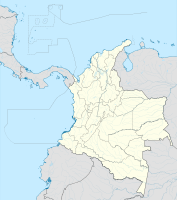Soacha
| Soacha | ||
|---|---|---|
|
Coordinates: 4 ° 35 ′ N , 74 ° 13 ′ W Soacha on the map of Colombia
|
||
|
Location of the municipality of Soacha on the map of Cundinamarca
|
||
| Basic data | ||
| Country | Colombia | |
| Department | Cundinamarca | |
| City foundation | 1600 | |
| Residents | 556,268 (2019) | |
| City insignia | ||
| Detailed data | ||
| surface | 184 km 2 | |
| Population density | 3,023 inhabitants / km 2 | |
| height | 2565 m | |
| Post Code | 250051-250055 | |
| Time zone | UTC -5 | |
| City Presidency | Juan Carlos Saldarriaga Gaviri (2020-2023) | |
| Website | ||
| City bus between Bogotá and Soacha | ||
Soacha is a municipality ( municipio ) in Colombia that the metropolitan Bogotá belongs. It is located in the Cundinamarca department , immediately south of Bogotá in the Sabana de Bogotá .
geography
Soacha is located in Cundinamarca in the province of Soacha at an altitude of about 2265 m, the average temperature is 11.5 ° C. The municipality borders in the north on Bojacá and Mosquera , in the south on Sibaté and Pasca , in the west on Granada and San Antonio del Tequendama and in the east on the districts of Bosa and Ciudad Bolívar in Bogotá .
population
The municipality of Soacha has 556,268 inhabitants, of which 550,054 live in the urban part (cabecera municipal) of the municipality (as of 2019).
history
Even before the colonization there was a Chibcha settlement called Guacha on the site of today's Soacha. In 1600 the Spaniard Luis Henríquez founded the new town of Suacha , which remained an insignificant village until the middle of the 19th century .
According to a census on September 4, 1759 , 332 Indians lived in Soacha, and 430 personas were in the population register. Eleven years later, statistics show that 611 Indians and 718 whites lived in Soacha.
On July 12, 1785 , an earthquake destroyed the town's church, which was rebuilt by 1791 . On November 16, 1827 , the new church was destroyed by another earthquake; the then newly built church suffered the same fate on September 1, 1917 . It was renovated and reopened in 1921 and damaged again by the earthquake on February 9, 1967 .
In 1875 the place was renamed Soacha and recognized as an official place in the province of Cundinamarca. In 1895 construction began on the southern line of the Bogotá railway, which led to Soacha, which was then 18 kilometers away, and which was completed in 1898 . A year later the railway line was extended to the Tequendama waterfall and Soacha was connected to the telegraph network.
20th and 21st centuries
In 1900 a hydropower plant was completed near Soacha , which supplied the capital Bogotá with electricity, and in 1950 a dam was built to increase electricity production. In addition, the road to Bogotá was expanded, so that from then on buses connected the place with the capital. The railroad lost its importance and finally ceased operations in 1989.
According to the 1973 census, Soacha had just under 28,000 inhabitants, in 1985 it was the second largest city in Cundinamarca after Girardot with 122,276 inhabitants .
Soacha became known when on August 18, 1989 the presidential candidate of the Liberal Party , Luis Carlos Galán , was murdered at an election rally there.
Infrastructure
Due to its geographical proximity to the capital, Soacha is currently one of the fastest growing cities in Colombia. The population has more than tripled since 1985 and is currently over 500,000. Soacha now connects seamlessly to the belt of misery in the south of Bogotá and has a similar social structure, characterized by poverty and shortage. Since the beginning of the 1990s, Bogotá's Bosa district has grown so much that the city limits can no longer be seen from the main street. In particular, on the mountain slopes east of the city, new urban districts are constantly emerging that have almost no infrastructure. Most residents commute to Bogotá to work.
The Autopista Sur , the expressway to Girardot , Ibagué and the Cauca Valley, one of the most important east-west arteries in Colombia, runs through Soacha . In the future, the TransMilenio bus system from the capital Bogotá to Soacha is to be continued.
In addition to the numerous slaughterhouses , many large factories have settled on the southern edge of Soacha in recent years. On the one hand, this leads to a high level of environmental pollution, on the other hand, it has created numerous local jobs.
sons and daughters of the town
- Joaquín Piñeros Corpas (1915–1982), writer and politician
Web links
- Alcaldía Municipal de Soacha. Alcaldía de Soacha - Cundinamarca, accessed on June 10, 2019 (Spanish, website of the municipality of Soacha).
Individual evidence
- ↑ Information on geography on the official Soacha website
- ↑ ESTIMACIONES DE POBLACIÓN 1985 - 2005 Y PROYECCIONES DE POBLACIÓN 2005 - 2020 TOTAL DEPARTAMENTAL POR ÁREA. (Excel; 1.72 MB) DANE, May 11, 2011, accessed on June 10, 2019 (Spanish, extrapolation of the population of Colombia).




